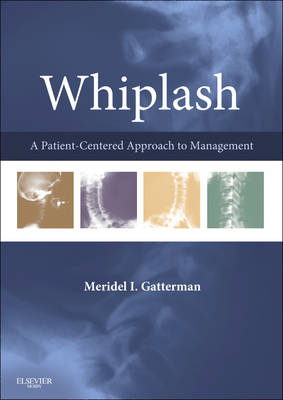
Whiplash
Mosby (Verlag)
978-0-323-04583-4 (ISBN)
- Titel ist leider vergriffen;
keine Neuauflage - Artikel merken
Providing a balanced, evidence-based discussion of whiplash and its associated disorders, "Whiplash: A Patient Centered Approach to Management" compiles information from many sources into a single, definitive reference. It clearly delineates rationales and procedures, covering cervical spine anatomy, neurology, kinesiology, epidemiology, patient history and assessment, imaging, soft tissue injuries, articular lesions, rehabilitation, and prognosis. Using numerous full-color photos and illustrations, an expert author team led by Dr. Meridel Gatterman offers concrete guidelines for a patient-centered approach to care of whiplash and whiplash-related conditions - one that recommends minimally invasive procedures and therapies whenever possible. A companion Evolve website includes video clips showing stretching exercises, printable patient handouts, and narrated PowerPoint slides.
1. Introduction "Whiplash" as an Entity Whiplash: What is it? The Epidemiology of "Whiplash" Injuries Patient-Centered Care The Characteristics of Patient-Centered Care Emphasis on Self Healing Holistic Approach to the Patient A Humanist Attitude Working with Patients as Partners Shared Decision Making Integrative Care The Paradigm Concept Clashing Paradigms What is Integrative Care? Evidence-Based Care History of Whiplash Terminology Mechanism of Injury 2. Functional Anatomy of the Cervical Spine Embryological Development of the Spinal Motion Segments Somatogenesis Components of the Lower Spinal Motion Segments The Autonomic Nervous System Conclusion 3. Patient History and Mechanism of Injury Brachial Plexus CNS ANS 4. Physical Examination Listening to the Patient The Pain Drawing Chief Complaints and General Assessment Analysis of Cervical Motion Segmental Cervical Movement Neurological Evaluation Sensory Testing Reflexes Testing for Muscle Strength Provocation Tests for Cervical Spine Disorders Compression Tests Foraminal Compression Assessment of Cervical Nerve Function Through Compression Disc Herniation Distraction Differentiation of Sprain from Sprain Assessment of Vertebral Artery Function Cervicobrachial Pain Outcome Evaluation Neck Disability Index 5. Imaging Acute Injury Chronic Injury 6. Management of Muscle Injury and Myofascial Pain Syndromes Historical Overview of Muscle Pain Literature Theoretical Models of Muscle and Myofascial pain 7. Headache in Whiplash: A Comprehensive Overview Taking a Headache History Types of Headache That Might be Encountered Examining the Headache Patient Deciding What the Diagnoses are What are Possible Mechanisms of Whiplash-associated Headache? Managing Headache in the Whiplash Patient 8. Whiplash Associated Disorders of Joints and Ligamentous Structures Stability of the Cervical Spine and Whiplash Injury Cervical Joint Sprain Whiplash Associated Joint Dysfunction Clinical Indicators of Cervical Subluxation Palpatory Findings Indicating Cervical Subluxation Reliability and Validity of Clinical Indicators of Subluxation Syndromes Associated with Subluxation of the Cervical Articulations Whiplash Associated Headache Related to Joint Subluxation Incidence of Post Whiplash Headache Headache Response to Manipulation Posterior Cervical Sympathetic Syndrome and the Vertebral Arteries Cervicogenic Dorsalgia Cervical-Brachial Syndrome Conservative Management of Cervicobrachial Pain Cervical Subluxation Syndromes 9. Epidemiology of Whiplash Injuries Basic Epidemiological Terms Frequency of Whiplash Whiplash Risk Factors Societal Impact A Whiplash Culture Prevention 10. The Safety and Effectiveness of Common Treatments for Whiplash Judging Safety and Effectiveness: An Evidence Based Approach The Quebec Whiplash Task Force The Bone & Joint Decade Task Force Comparing Safety and Effectiveness of Common Therapies Simple Analgesics Other Drugs Evidence for Pharmacological Therapies Conservative Physical Treatments Non-conservative Interventions Surgical Interventions 11. Prognosis of Whiplash Associated Disorders Prognostic Factors Psychological and Psychosocial Factors That Delay Recovery In the Patient's Interest
| Erscheint lt. Verlag | 1.7.2011 |
|---|---|
| Zusatzinfo | 150 illus. |
| Verlagsort | St Louis |
| Sprache | englisch |
| Maße | 184 x 260 mm |
| Themenwelt | Medizin / Pharmazie ► Physiotherapie / Ergotherapie ► Behandlungstechniken |
| Recht / Steuern ► EU / Internationales Recht | |
| ISBN-10 | 0-323-04583-9 / 0323045839 |
| ISBN-13 | 978-0-323-04583-4 / 9780323045834 |
| Zustand | Neuware |
| Haben Sie eine Frage zum Produkt? |
aus dem Bereich


